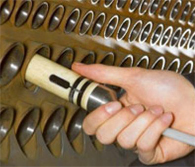- Home
- About Us
- Inspection Services
- Conventional Non-Destructive Testing
- Ultrasonic Weld Scan
- Ultrasonic Thickness Gauging
- Eddy Current Testing
- Radiography Testing
- Liquid Penetrant Testing
- View More

Remote Field Testing or “RFET” is one of several electromagnetic testing methods commonly employed in the field of non-destructive testing. Other electromagnetic inspection methods include magnetic flux leakage, conventional eddy current, and alternating current field measurement testing. Remote field testing is associated with eddy current testing and the term “Remote Field Electromagnetic Testing” is often used when describing remote field testing. However, there are several major differences between eddy current testing and remote field testing which will be noted in this section.
RFET is primarily used to inspect ferromagnetic tubing since conventional eddy current techniques have difficulty inspecting the full thickness of the tube wall due to the strong skin effect in ferromagnetic materials.
For example, using conventional eddy current bobbin probes to inspect a steel pipe 10 mm thick (such as what might be found in heat exchangers) would require frequencies around 30 Hz to achieve adequate I.D. to O.D. penetration through the tube wall. The use of such a low-frequency results in a very low sensitivity of flaw detection. The degree of penetration can, in principle, be increased by the use of partial saturation eddy current probes, magnetically biased probes, and pulsed saturation probes. However, because of the large volume of metal present as well as potential permeability variations within the product, these specialized eddy current probes are still limited in their inspection capabilities.
The difficulties encountered in the testing of ferromagnetic tubes can be greatly alleviated with the use of the remote field testing method. The RFET method has the advantage of allowing nearly equal sensitivities of detection at both the inner and outer surfaces of a ferromagnetic tube. The method is highly sensitive to variations in wall thickness and tends to be less sensitive to fill-factor changes between the coil and tube. RFET can be used to inspect any conducting tubular product, but it is generally considered to be less sensitive than conventional eddy current techniques when inspecting non-ferromagnetic materials.
Suitable for ferromagnetic tubes such as those found in heat exchangers and boilers.
Localized corrosion, Pittings.
Equally sensitive to internal and external flaws.
Can inspect tubes up to 75mm OD with 5mm thickness.
Relatively insensitive to probe liftoff or wobble.
Typical pull speed between 6” and 12” per second.